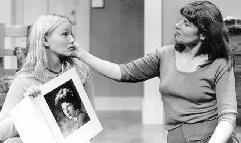SEARCH CurtainUp
On TKTS
Letters to Editor
REVIEWS
FEATURES
ADDRESS BOOKS
Broadway
Off-Broadway
DC
NEWS (Etcetera)
BOOKS and CDs
(with Amazon search)
OTHER PLACES
Berkshires
DC (Washington)
London
Los Angeles
QUOTES
FILM
LINKS
MISCELLANEOUS
Free Updates
Masthead
Type too small?
NYC Weather
A
CurtainUp  Berkshire Review
Berkshire Review
Full Bloom
 Onement ! by Barnett Newman |
Like that line in the painting which pops out at Phoebe every time she visits the museum, Phoebe's good looks have popped out into full bloom. Her suddenly striking prettiness has made her visible in a new way -- to boys, her mom and the neighboring couple in their New York apartment house who are like second parents to her. But instead of enjoying all the attention, it makes this very smart and sensitive female counterpart of the Catcher in the Rye's Holden uncomfortably aware of the emphasis on youthful beauty and the devaluation of those who no longer have it -- like her mom, once a homecoming queen now forced to deal with her husband's leaving her for a much younger woman; and the neighbor who is having an eye tuck to revive her flagging acting career.
While neither playwright Suzanne Bradbeer or her troubled young heroine shed any definitive light on Barnett Newman's enigmatic painting, it nevertheless serves as a potently symbolic leitmotif for Phoebe's story (the painting's bright orange line becomes invisible just as the increasingly despondent girl seems to fade into a pale shadow of the vibrant girl we see in the opening scene). Phoebe, is also unlikely to become a literary icon like her inspirational source, but as engagingly and convincingly portrayed by Kelli Giddish, you won't soon forget her or the societal issues Ms. Bradbeer's world premiering play raises.
 Kelli Giddish & Christine Farrell (Photo: Richard Feldman ) |
The three adults are sympathetically drawn and played, but Full Bloom belongs to the two teenagers. Ms. Giddish shows Phoebe's becoming paler and less in touch with herself with a sensitivity that belies her limited theatrical experience. Michael Benjamin Washington comes close to stealing the show as the likeable, persistent Jesse. He is as much, a Salinger character as Phoebe; in fact, like the novel's Phoebe, Washington's Jesse shines as the sensible, support system, the character whose loyalty symbolizes hope even after tragedy strikes.
Taking a cue from the author, Sarah Lambert, has used the work of another visual artist, Joseph Cornell, to create a simple but aptly attractive arrangement of boxes to create three spaces -- the front entry to Phoebe's apartment house, the living room of her apartment and the fire escape -- with a generic street and narration area upstage. Lit by Victor En Yu Tan and with sound design by Bruce Ellman, it all makes for a thoroughly professional production.
In a recent NYTimes Magazine article Terence Riley, a curator at the Museum of Modern Art, stated that the young people attending the avante garde architect Rem Koolhaas' lectures "come out with questions, not answers." This could easily apply as a test for the relevance of a play and in the case of Full Bloom, audiences certainly have plenty of questions to think about and discuss long after they leave the theater.
LINKS
For more on Holden Caulfield and a link to a paperback edition of The Catcher in the Rye, check out CurtainUp's feature Holden Caulfield, Theater Aficionado.
| FULL BLOOM By Suzanne Bradbeer Directed by Mary B. Robinson Cast (in order of appearance): Kelli Giddish, Christine Farrell, Gordana Rashovich, Gerard O'Brien, Michael Benjamin Washington Set Design: Sarah Lambert Costume Design: Mattie Ullrich Lighting Design: Victor En Yu Tan Sound Design: Bruce Ellman Running time: 1 hour and 30 minutes without intermission Barrington Stage at Consolati Performing Arts Center Sheffield, MA (513) 528-8888 http://www.barringtonstageco.org 7/19/2000-8/06/200; opening 7/22/2000 Reviewed by Elyse Sommer based on 7/22 performance |


